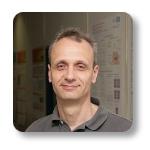Séminaire : Terahertz sources based on quantum cascade heterostructures – Juraj Darmo
In the framework of MNO department, IEMN is pleased to announce the seminar of Dr. Juraj Darmo
Date : thursday 4 mai at 15h00
Location : Salle du Conseil – IEMN-LCI
Pr. Juraj Darmo : Photonics Institute, Vienna University of Technology Gusshausstr. 27-29, 1040 Vienna (Austria)
 The state-of-the-art of terahertz (THz) sources based on quantum cascade heterostructures will be reviewed from the viewpoint of short pulse generation. There are two principal applications of the concept of quantum cascade – for the emission and for the detection of terahertz waves. On the emitter’s side, THz quantum cascade lasers (QCLs) are increasingly exploited for sensing and imaging applications. Today QCLs span a frequency range from 1.8THz to 5 THz with record peak output powers of 1 W and CW single-mode average powers in the 100s mW range. Recently, a concept of heterogeneous QCL active region has been successfully implemented leading to broadband emission over one octave and even to frequency comb operation with a 600 GHz bandwidth. Such active medium can be used for the generation of short (bandwidth limited) pulses.
The state-of-the-art of terahertz (THz) sources based on quantum cascade heterostructures will be reviewed from the viewpoint of short pulse generation. There are two principal applications of the concept of quantum cascade – for the emission and for the detection of terahertz waves. On the emitter’s side, THz quantum cascade lasers (QCLs) are increasingly exploited for sensing and imaging applications. Today QCLs span a frequency range from 1.8THz to 5 THz with record peak output powers of 1 W and CW single-mode average powers in the 100s mW range. Recently, a concept of heterogeneous QCL active region has been successfully implemented leading to broadband emission over one octave and even to frequency comb operation with a 600 GHz bandwidth. Such active medium can be used for the generation of short (bandwidth limited) pulses.
In this work we have exploited broadband QCLs active regions to demonstrate an alternative route to boost the performance of time-domain spectroscopy (TDS), the main spectroscopic technique used in the THz frequency range. The available broad THz QCL gain is used to amplify a weak broadband THz spectrum generated through optical-to-THz low-efficiency conversion. In the 2.0-3.0 THz window this approach leads to an increase of SNR by two orders of magnitude compared to a standard TDS system. Moreover we demonstrate the generation of amplified pulses as short as 2.5 ps and analyse hurdles preventing us from exploiting all the gain bandwidth available from the broadband THz QCL gain medium. The presentation will end with an outlook on the future developments of the presented technology.















